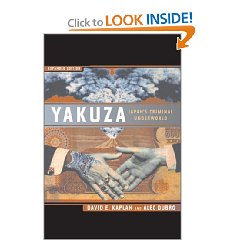There is an excellent section of the book that focuses on how the US government fostering of political corruption in Japan in turn led to US corporate corruption, to include the funding of separate US corporate foreign policies anti-thetical to those Congress was trying to foster in the days before Congress abdicated its responsibilities.
Lee Kuan Yew would like this book. He says the only antidote to organized crime is strong extended families–natural families whose kinship equates to ethics. The book documents the spread of crime in Japan to every aspect of life, and one can only be saddened to see how the concepts of samurai honor and loyalty have been turned upside down.
Three ideas keep running through my mind as I read the book, two of them from the author and the third my own. First, the authors focused on the importance of following the money. He knew and wrote about this in the mid-1980's, but today the US Government is still marginally able to follow money, especially informal money that the FBI only discovered in the late 1990's with help from Dick Clarke (see my review of “Against All Enemies”). Following the money is *the* intelligence challenge of the 21st Century, and it is not something CIA can do–we have to find means of integrating all seven tribes, and especially business and banks as well as law enforcement at every level. Second, the author documents the weakness of Japanese law enforcement in a manner that highlights the weakness of US law enforcement at the state and local levels. Think of this book as traveling back in time to Japan, and then forward in time to the US, where we are now suffering many of the same problems. Finally, being a fan of Special Operations properly done, I realized that 21st Century warfare is going to be about man-hunts. It is going to be about tribal and criminal orders of battle, and about decapitating terrorist and criminal gangs without mercy.
The book spends some time on how US forces overseas are in fact a major stimulant and catalyst for crime, especially drugs and trade in women and children. By sending our forces and their money into austere conditions, we have actually created 750 “crime magnets” all over the world. And if you think our secret bases overseas are secret from anyone other than the US public, think again–one has only to ask the prostitutes. There is another important aspect of GI (Government Issue) life overseas: too many of our naive GI's get sucked into crime, first from small loans, then being asked to smuggle small things, then big things, to pay off the loan, and then being tracked down, after returning home, to be brought into international crime within the USA. I realized from this that DoD needs a crime counterintelligence and amnesty program, and we need to out-brief every GI on how to handle criminal blackmail when they encounter it, both overseas, at home, and post-service.
The book ends with a fascinating and thoughtfully-selected series of vignettes on the spread of Yakuza crime to 21 countries. The study of their passports is especially interesting, and makes us wonder why the US Treasury is still spending most of its time, two years after 9-11, trying to harass those trading with Cuba, instead of going after terrorist and criminal money.
Toward the end of the book there is a useful professional discussion of how inept governments are at identifying correct names and name variants when trying to spot and monitor criminals. This is a real problem. Within the US Intelligence Community, there is no standard for international names, each agency doing its own thing, with the result that even if we were to connect all the databases, the decades of unstandardized data entry across the archipelago makes many of our records too hard to use–almost as if we have to start from scratch.
One final point that really jumped out at me: the authors do a great job of identifying the real experts on Yakuza, across many countries, and what struck me was that they exist but no one has figured out how to create a virtual community of interest with the Internet such that all of them are security in touch with one another, sharing name databases, libraries, photograph archives, etcetera. The obsession with secrecy and national control remains the greatest obstacle to actually doing well against crime, and we appear to need regional information sharing systems that are NOT secret (just secure), and multinational regional “stations” against crime.
Closing comment: the book documents the incompetence of the US approach to manning its Embassies, especially in the law enforcement arena, where individuals are not language qualified, have no idea of the culture or history, and rotate every two years just as they are finally getting wise. We need a “long haul” manning strategy, and in my view should start thinking in terms of 10-year assignments with every second person coming in at the 5-year mark for solid continuity of intelligence and counterintelligence against these clear and present threats to national security and prosperity.
Outstanding book. A classic relevant to any country, any business, any government, at any level.





